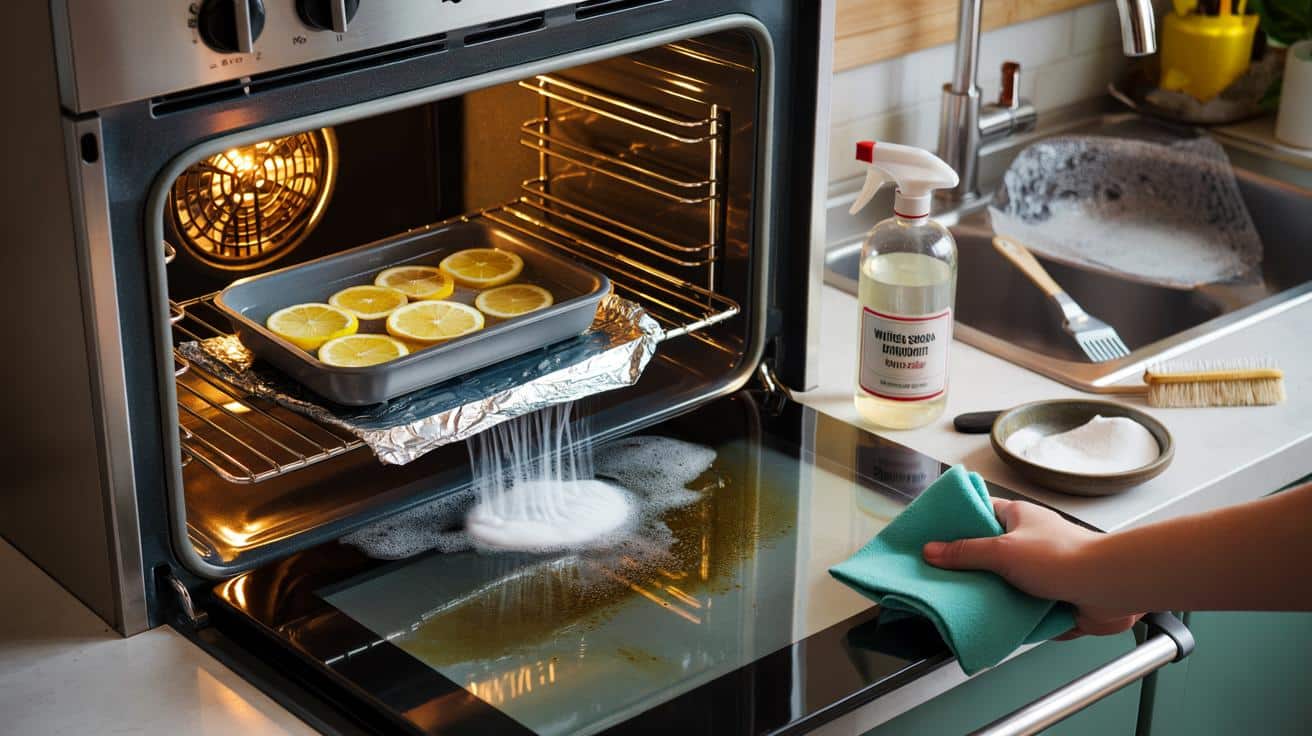Grease on the glass, burnt sugar on the rails, that faint smoky tang clinging to your roast potatoes — a dirty oven steals heat and mood. You don’t need harsh chemicals to fix it. You just need timing, kitchen staples, and a few gentle moves that pay you back next bake.
A tray of peaches hisses as syrup snaps on the foil, and somewhere beneath it, last week’s shepherd’s pie has left a memory in brown. You wave the smoke alarm with a tea towel and swear the tart tasted better last summer when the oven felt… lighter.
Later, when the kitchen is quiet, you notice it. The glass is dull. The racks feel sticky. You’re cooking inside a story of old dinners. We’ve all been there.
It takes less elbow grease than you think. You can keep that heat where it belongs — inside — and shave minutes off the next bake without the sting of caustic fumes. The fix starts long before the next bake.
Why a cleaner oven cooks better
A clean oven holds heat like a thermos. Sticky carbon acts like a blanket in the wrong places, slowing preheat and muting the blast of hot air that gives pastry lift and crisps chicken skin. When the glass is clear, you can watch the rise without opening the door and dumping warmth into the room.
There’s a human rhythm to it, too. When an oven smells like old fat, you second-guess timings, hover, faff with the tray, and open the door twice. A clean box changes how you cook — you trust the clock, you let it be. Food gets a fair go, and your fan isn’t fighting against fuzzed-up vents and baked-on crumbs.
I spent an evening in a friend’s terrace kitchen in Leeds, where she switched to simple cleaning last winter. She wiped while warm, gave the racks a bath each month, and skipped the brutal spray she used to hate. She swears her sourdough started browning more evenly. The win she didn’t expect: her preheat felt snappier, and the oven light stayed clear so she stopped peeking.
The logic tracks. Grease and carbon are poor conductors, so they slow heat transfer from metal to air and from air to food. They also smoke at lower temperatures, which masks aroma and can make you bail early. A clouded window invites door-opening. Door opening dumps heat and stretches cooking time. Keep the seals springy, the glass see-through, and the air paths open, and your oven behaves like the one you paid for.
Gentle methods that actually work
Start with the safest workhorse: bicarb of soda. Mix bicarb with warm water into a spreadable paste. Paint it on the cool interior, avoiding the heating elements and fan cut-outs, and leave it to sit for at least 30 minutes — overnight if the grime is ancient. Wipe with a damp microfibre cloth, then spritz a little white vinegar to cut any chalky film, and wipe again. Use a plastic scraper on the glass where splatters have set hard.
Racks deserve their own spa. Slide them out and soak in the bath or a deep sink with hot water and soda crystals or a dishwasher tablet. After an hour, a gentle scrub with a dish brush lifts the sticky glaze. For the door glass, a paste of bicarb and a drop of washing-up liquid helps. Let dwell time do the heavy lifting. Let’s be honest: nobody actually does that every day.
There’s a quick-save for fresh spills: throw ordinary table salt onto the hot patch as soon as you pull the tray out. The salt dries sticky fat, turning it crumbly so it scrapes off when the oven is cool. Lemon steam also helps. Place a shallow tray of water with thick lemon slices on the middle shelf at 180°C for 20 minutes, then wipe the softened walls while warm.
“Since I switched to bicarb and steam, I stopped dreading cleaning day. The oven smells like food again, not a spray can.”
- Microfibre cloths and a soft sponge
- Bicarb of soda and white vinegar
- Salt for the hot-spill trick
- Lemons for a quick steam clean
- Plastic scraper for glass (no metal on enamel)
- Soda crystals for soaking racks
- Old toothbrush for door seals and corners
- Silicone baking mats or a reusable oven liner (trimmed to fit, never covering vents)
Make it a habit without the hassle
Build it into your cooking, not your weekend. When you turn the oven off, wait five minutes. While it’s still warm, wipe the door and the floor of the cavity with a damp cloth. You’ll catch the easy stuff before it hardens into archaeology. Cover splashy casseroles, and slide a tray under pies and pizzas to catch drips. A clear window and a working light mean you don’t lose heat to curiosity.
Little checks save energy. Run your finger along the rubber door seal — if it’s brittle or split, it leaks. Keep the fan guard free of fluff. Don’t spray liquids at the elements or into gas ports. Skip the self-clean cycle unless you truly need it; it uses a lot of heat, and you’ll still wipe ash. If you use a liner, keep it flat on a shelf, not on the base, and never block vents. Tiny moves, big effect.
Be kind to the surfaces. Steel wool scars enamel. Cream cleansers can haze glass. Vinegar and bicarb neutralise each other, so use them in sequence, not as a fizzing party trick. A damp cloth with a little washing-up liquid cleans more than you think. If a stain laughs at you, give it time with bicarb paste and come back. On a tough week, salt a spill and call it a day. You’ll win the next round.
There’s another quiet benefit to this softer approach. Food tastes cleaner when the oven does. That smoky undertone fades, and you stop opening the door to “check the smell”. Your roast doesn’t fight an old chip-shop note. Your cakes rise without catching on a hot splatter. Small rituals change how you cook more than heroics ever will.
One more nudge for the next bake: keep a dedicated “oven cloth” on the handle. It reminds you to wipe while warm. Tuck a cheap oven thermometer on a rack once a month to see if your dial is honest. If the reading drifts, adjust your timings rather than cranking up heat. You’ll save gas or electric simply by trusting clean surfaces and steady habits.
On a weekday evening, when the pasta bake is out and the plates are clattering, the idea of “cleaning the oven” feels like a joke. Start with a 30-second wipe, a pinch of salt on that bubble-over, and the lemon tray on Sunday. Next time you preheat, it will feel quicker. The kitchen will smell like dinner, not last month. That’s the real win waiting quietly behind the door.
And if you need a mantra, make it friendly: warm wipe, slow soak, lemon steam. Share it, borrow it, bend it to your kitchen. The aim isn’t perfection. It’s an oven that loves heat and gives it back without a fight.
| Key points | Detail | Reader Interest |
|---|---|---|
| Use gentle staples | Bicarb paste, vinegar follow-up, lemon steam, salt on fresh spills | Low-cost, low-odour, safe around homes |
| Clean for faster, steadier heat | Clear glass reduces door-opening, less carbon means better heat transfer | Quicker preheats, more even bakes |
| Make it a tiny habit | Wipe while warm, soak racks monthly, watch seals and vents | Less effort than “big cleans”, better results |
FAQ :
- What’s the quickest no-chemical clean after a messy roast?While the oven is still warm, sprinkle salt over fresh spills, let it cool, then brush away and wipe with a damp cloth. Follow with a short lemon steam if it’s smoky.
- Can I use vinegar and bicarb together?Yes, but use them one after the other. Bicarb paste first for dwell time, wipe, then a light vinegar spritz to remove residue. Mixing at once mostly cancels both.
- How do I clean the glass without scratching it?Use bicarb and warm water paste, a soft sponge, and a plastic scraper. Avoid steel wool and gritty creams that can haze the pane.
- Are oven liners safe?Reusable liners are fine when trimmed to fit a shelf and kept flat. Don’t cover vents or lay them on the oven floor, and skip anything that warps at high heat.
- Do I need the self-clean cycle?Only for extreme build-up. It draws a lot of energy and still needs a wipe after. Regular warm wipes and monthly soaks keep you from needing it.








